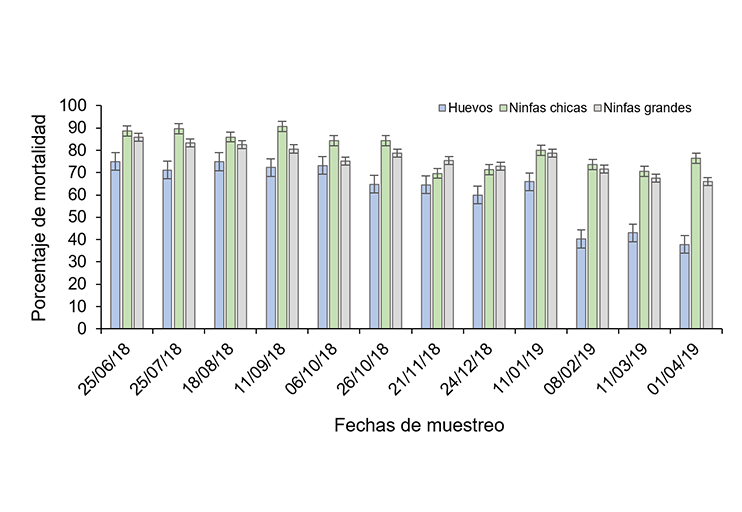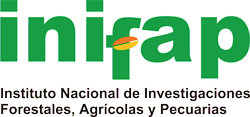Biological effectiveness of imidacloprid on the Asian citrus psyllid
DOI:
https://doi.org/10.29312/remexca.v16i2.3409Keywords:
Chemical control, insecticide, mortalityAbstract
Diaphorina citri Kuwayama, better known as the Asian citrus psyllid, is the main pest of the Persian lime due to the direct and indirect damage it causes and, currently, there are not enough chemical insecticides for its control in the field. Therefore, this work aimed to determine the biological effectiveness of 12 successive applications of imidacloprid at 25-day intervals on immature Asian citrus psyllid individuals in a Persian lime grove in order to define whether the effectiveness of the pesticide decreases as a function of the number of sprays. Before applying the insecticide, 18 tender shoots were sampled and 72 h after application, the number of live immature D. citri individuals was counted. A completely randomized design was used and mortality data were subjected to an analysis of variance. The biological effectiveness of imidacloprid on D. citri was high (up to 90%) during the first successive applications, then mortality on eggs declined by 10% in the sixth application, whereas in the tenth, it decreased significantly by more than 30%. In small nymphs, the reduction in mortality was 10% from the seventh application and in the tenth, it was significantly lower (17%). In large nymphs, the reduction in mortality was 10% in the seventh application while in the eleventh, it significantly declined (18%). In conclusion, the biological effectiveness of imidacloprid decreased after several successive applications on immature D. citri individuals.
Downloads
References
Ahmed, S.; Ahmad, N. and Khan, R. R. 2004. Studies on population dynamics and chemical control of citrus psylla, Diaphorina citri. Int. J. Agric. Biol. 6(6):970-973.
Alemán, J.; Baños, H. y Ravelo. 2007. Diaphorina citri y la enfermedad huanglongbing: una combinación destructiva para la producción citrícola. Revista de Protección Vegetal. 22(3):154-165.
Alves, G. R.; Diniz, A. J. and Parra, J. R. 2014. Biology of the huanglongbing vector Diaphorina citri (Hemiptera: Liviidae) on different host plants. J. Econ. Entomol. 107(2):691-696. https://doi.org/10.1603/EC13339.
Arias, F. J. y Suárez, E. A. 2016. Comportamiento de las exportaciones de limón persa (Citrus latifolia Tanaka) al mercado de los Estados Unidos. J. Agri. Anim. Sci. 5(2):22-33. Doi:10.22507/jals.v5n2a2.
Borja, B. M.; Velez, I. A.; Cuevas, R. V. and Orozco, S. M. 2021. Profitability and competitiveness of Mexican in an endemic Huanglongbing environment under two technological approaches. Revista Ciencia y Sociedad. 16(1):102-115. https://doi.org/10.29059/cienciauat.v16i1.1495.
Cortez, M. E.; Loera, G. J.; Hernández, F. L. M.; Barrera, G. J.; Fontes, P. A.; Díaz, Z. U.; Jasso, A. J.; Reyes, R. M.; Manzanilla, R. M. y López, A. J. 2013. Manual para el uso de insecticidas convencionales y alternativos en el manejo de Diaphorina citri Kuwayama en cítricos, en México. Secretaría de Agricultura, Ganadería, Desarrollo Rural, Pesca y Alimentación (SAGARPA)-Instituto Nacional de Investigaciones Forestales, Agrícolas y pecuarias (INIFAP). Juan José Ríos, Sinaloa. Folleto técnico núm. 37. 56 p. ISBN: 978-607-37-0016-0.
Cortez, M. E.; Ortiz, O. A. y Pérez, M. J. 2021. Insectos y ácaros plaga, descripción y manejo. Manual de producción de cítricos en el estado de Sinaloa. Instituto Nacional de Investigaciones Forestales, Agrícolas y pecuarias (INIFAP)-CIRNO-CEVACU. Sinaloa, México. Libro técnico no. 1. 74-107 pp. ISBN: 978-607-37-1377- 1.
Della, V. J.; De Andrade, D.; Gomes, A. R. and Da Costa, F. M. 2019. Effects of insecticide and acaricide mixtures on Diaphorina citri control. Revista Brasileira de Fruticultura. 41(1):1-7. https://doi.org/10.1590/0100-29452019076.
Díaz, Z. U. 2010. Estudio de evaluación de efectividad biológica de Actara®, para controlar diaphorina en limón persa (Citrus latifolia Tan.). 1er simposio nacional sobre investigación para el manejo del psílido asiático de los cítricos y el Huanglongbing en México. Monterrey, N. L. México. INIFAP-CIRNE. 396-407 pp.
Fajun, T. A.; Xiufang, M. E.; Syed, A. H.; Chaofeng, L. L. & Xinnian, Z. A. 2018. Detection and biochemical characterization of insecticide resistance in field populations of Asian citrus psyllid in Guangdong of China. Sci. Rep. 8(12):1-11. Doi:10.1038/s41598-018-30674-5.
Fernández, M. C. y Giménez, R. A. 2005. Impacto de imidacloprid en la descomposición orgánica edáfica en cultivo de duraznero. Agricultura Técnica. 64(4):370-377.
Flores, S. J.; Mora, A. G.; Loeza, K. E.; López, A. J.; Domínguez, M. S.; Acevedo, S. G. y Robles, G. P. 2015. Pérdidas en producción inducidas por Candidatus Liberibacter asiaticus en limón Persa en Yucatán, México. Revista Mexicana de Fitopatología. 33(2):195-210.
García, L. E. and Cortez, M. E. 2020. The flat citrus mite and its association with the severity of greasy leaf spot damage in Persian lime in Sinaloa, Mexico. Southwest. Entomol. 45(1):329-332. https://doi.org/10.3958/059.045.0139.
García, M. V.; Ortega, A. L.; Villanueva, J. J. and Osorio, A. F. 2019. Resistance of Diaphorina citri Kuwayama to insecticides in five regional control areas in Mexico. Southwest. Entomol. 44(4):947-954. https://doi.org/10.3958 /059.044.0415.
García-Méndez, V. 2013. Susceptibilidad de Diaphorina citri Kuwayama (Hemiptera: Liviidae) a insecticidas en Veracruz, México. Tesis de Maestría. Colegio de Postgraduados, Campus Montecillo, Postgrado de Fitosanidad. 41 p. https://swfrec.ifas.ufl.edu/hlb/database/pdf/25-Garcia-Mendez-13.pdf.
García, Y. A; Ramos, Y. P; Sotelo, P. A. y Kondo, T. T. 2016. Biología de Diaphorina citri (Hemiptera: Liviidae) bajo condiciones de invernadero en Palmira, Colombia. Revista Colombiana de Entomología. 42(1):36-42.
Gibbons, D.; Morrissey, C. and Mineau, P. 2015. A review of the direct and indirect effects of neonicotinoids and fipronil on vertebrate wildlife. Environ. Sci. Pollut. Res. Int. 22(1):103-118. Doi: 10.1007/s11356-014-3180-5.
Hernández, T. J. y Botello, T. J. 2017. El papel del entorno en las modificaciones de la estructura regional de la producción de limón y naranja en México. Revista de Análisis Económico. 32(80):93-118.
IRAC. 2022. Insecticide Resistance Action Committee. IRAC mode of action classification Scheme. Version 10.3. https://irac-online.org/mode-of-action/.
Kaufman, P. E.; Nunez, S. C.; Mann, R. S.; Christopher, G. J. and Scharf, M. E. 2010. Nicotinoid and pyrethroid insecticide resistance in houseflies (Diptera: Muscidae) collected from Florida dairies. Pest Manag. Sci. 66(2):290-294.
Ladaniya, M. S.; Marathe, R. A.; Das, A. K.; Rao, C. N.; Huchche, A. D.; Shirgure, P. S. and Murkute, A. A. 2019. High density planting studies in acid lime (Citrus aurantifolia Swingle). Sci. Hortic. 261(5):136-145. http://dx.doi.org/10.1016/j.scienta.2019.108935.
Langdon, K. W. and Rogers, M. E. 2017. Neonicotinoid-induced mortality of Diaphorina citri (Hemiptera: Liviidae) is affected by route of exposure. J. Econ. Entomol. 110(5):2229-2234. Doi: 10.1093/jee/tox231.
Luna-Cruz, A. J. R.; Lomeli-Flores, E.; Rodríguez-Leyva, L.; Ortega-Arenas, A. and Huerta, P. 2011. Toxicidad de cuatro insecticidas sobre Tamarixia triozae (Burks) (Hymenoptera: Eulophidae) y su hospedero Bactericera cockerelli (Sulc) (Hemiptera: Triozidae). Acta Zoológica Mexicana. 27(3):509-526.
Mattos, D. J. 2018. The role of the international society of citriculture on the world citrus industry. Citrus Research and Technology. 38(2):228-232. Doi:10.4322/crt.ICC171.
Memmi, B. K. 2010. Mortality and knockdown effects of imidacloprid and methomylin house fly, Musca domestica L. (Diptera: Muscidae) populations. J. Vector Ecol. 35(2):144-148.
Mora, A. G.; Robles, G. P.; González, G. R; Flores, S. J.; Acevedo, S. G. y Domínguez, M. S. 2013. Criterios epidemiológicos para priorizar zonas de establecimiento de ARCOS. 3a Ed. México, DF. SENASICA. 124-135 pp.
Naeem, A.; Freed, S.; Liang, F. J.; Akmal, M. and Mehmodd, M. 2016. Monitoring of insecticide resistance in Diaphorina citri Kuwayama (Hemiptera: Psyllidae) from citrus groves of Punjab, Pakistan. J. Crop. Prot. 86(4):62-68. http://dx.doi.org/10.1016/j.cropro.2016.04.010.
Ramírez, G. A.; Puentes, P. G. y Restrepo, D. H. 2018. Evaluation of the efficacy of neonicotinoid and pyrethroid insecticides in Diaphorina citri Kuwayama (Hemiptera: Liviidae) populations in Colombia. Revista Colombiana de Ciencias Hortícolas. 12(2):358-368. https://doi.org/10.17584/rcch.2018vl2i2. 8093.
Ramírez-Sánchez, A.; Rodríguez-Maciel, L.; Lagunes-Tejeda, Á.; Bautista-Martínez, N.; Tejeda-Reyes, M. and Pardo-Melgarejo, S. 2023. Intraorchard variation of resistance to imidacloprid in Diaphorina citri (Hemiptera: Liviidae) adults. J. Entomol. Sci. 58(2):266-276. https://doi.org/10.18474/JES22-46.
Robles, G. A.; Arriaga, J. A. y Vázquez, P. M. 2016. Manual operativo de la campaña contra el huanglongbing de los cítricos. 2a Ed. México, DF. Dirección General de Sanidad Vegetal. 45 p.
Rodríguez, C. M. 2002. Guía técnica del cultivo de limón Persa. Centro Nacional de Tecnología Agropecuaria y Forestal, CENTA. 33 p. https://drive.google.com/file/d/1qwcrisi-kmurd-znrgdgxufseez0sajm/view.
Ruíz, G. I. 2013. Evaluación de insecticidas para el control del psílido asiático de los cítricos (Diaphorina citri) Kuwayama (Hemiptera: Liviidae) en sus diferentes estados biológicos en limón Persa. Tesis de Maestría. Postgrado de Fitosanidad, Colegio de Postgraduados. Montecillo, Texcoco, Estado de México, México. 37 p. https://swfrec.ifas.ufl.edu/hlb/database/pdf/3-RuizG-13.pdf.
San Martín, M. H.; Sánchez, S. E. y Núñez, P. R. 2021. Portainjertos y principales variedades de cítricos en Sinaloa. Manual de producción de cítricos en el estado de Sinaloa. INIFAP. Culiacán, Sinaloa, México. Libro técnico núm. 1. 14-27 pp. ISBN: 978-607-37-1377-1.
SADER. 2021. Secretaría de Agricultura y Desarrollo Rural. Plagas y enfermedades comunes del limón. https://www.gob.mx/agricultura/es/articulos/plagasyenfermedadescomunesdellimon?tab=.
SENASICA. 2017. Servicio Nacional de Sanidad, Inocuidad y Calidad Agroalimentaria. Huanglongbing de los cítricos. https://www.gob.mx/senasica/documentos/huanglongbing-de-los-citricos-110925.
SIAP-SAGARPA. 2022. Servicio de Información Agroalimentaria y Pesquera- Secretaría de Agricultura, Ganadería, Desarrollo Rural, Pesca y Alimentación. https://nube.siap.gob.mx/cierreagricola/.
Tiwari, S.; Killiny, N. and Stelinski, L. L. 2013. Dynamic insecticide susceptibility changes in Florida populations of Diaphorina citri (Hemiptera: Psyllidae). J. Econ. Entomol. 106(1):393-399. Doi: 10.1603/ec12281.
Vázquez, G. M.; Velázquez, M. V.; Medina, U. C.; Cruz, V. J.; Sandoval, S. M.; Virgen, C. G. and Torres, M. J. 2013. Insecticide resistance in adult Diaphorina citri Kuwayama from lime orchards in central west Mexico. Southwest. Entomol. 38(4):579-596. https://doi.org/10.3958/059. 038.0404.

Published
How to Cite
Issue
Section
License
Copyright (c) 2025 Revista Mexicana de Ciencias Agrícolas

This work is licensed under a Creative Commons Attribution-NonCommercial 4.0 International License.
The authors who publish in Revista Mexicana de Ciencias Agrícolas accept the following conditions:
In accordance with copyright laws, Revista Mexicana de Ciencias Agrícolas recognizes and respects the authors’ moral right and ownership of property rights which will be transferred to the journal for dissemination in open access. Invariably, all the authors have to sign a letter of transfer of property rights and of originality of the article to Instituto Nacional de Investigaciones Forestales, Agrícolas y Pecuarias (INIFAP) [National Institute of Forestry, Agricultural and Livestock Research]. The author(s) must pay a fee for the reception of articles before proceeding to editorial review.
All the texts published by Revista Mexicana de Ciencias Agrícolas —with no exception— are distributed under a Creative Commons License Attribution-NonCommercial 4.0 International (CC BY-NC 4.0), which allows third parties to use the publication as long as the work’s authorship and its first publication in this journal are mentioned.
The author(s) can enter into independent and additional contractual agreements for the nonexclusive distribution of the version of the article published in Revista Mexicana de Ciencias Agrícolas (for example include it into an institutional repository or publish it in a book) as long as it is clearly and explicitly indicated that the work was published for the first time in Revista Mexicana de Ciencias Agrícolas.
For all the above, the authors shall send the Letter-transfer of Property Rights for the first publication duly filled in and signed by the author(s). This form must be sent as a PDF file to: revista_atm@yahoo.com.mx; cienciasagricola@inifap.gob.mx; remexca2017@gmail.
This work is licensed under a Creative Commons Attribution-Noncommercial 4.0 International license.


